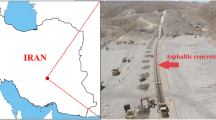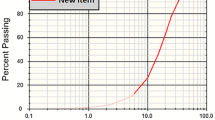Abstract
Rockburst is a typical dynamic phenomenon of mine destruction. With the expansion of mining scale and mining depth, its harm is becoming more and more serious. This has become an important problem to be solved urgently in the mining industry. This paper aims to study the prediction and prediction of rockburst risk based on particle swarm algorithm and neural network. This paper proposes a shock risk assessment method based on BP neural network. It uses existing shock pressure data to establish a regression model through BP network, and uses PSO algorithm to optimize connection weights to evaluate the slow convergence of BP network and easy to fall into local optimality. The shortcomings of and the degree of convergence was evaluated. In addition, this paper proposes a rockburst risk prediction method. In order to improve the accuracy of rockburst prediction, regional prevention and control measures and certain risk mitigation methods can also be quickly adopted. It not only identifies the mechanical properties of coal and rock mass in the laboratory, but also judges the possibility of rockbursts during mining. The experimental results in this paper show that 10 main factors that affect rockbursts are selected, 20 standard mechanical data sets are used, and a PSO-BP-based mine explosion risk assessment model is established, and the model is compared with the standard BP model Make a comparison. The results show that compared with the standard BP model, the evaluation accuracy of the PSO-BP model is increased by 15%. Finally, an example of mine risk assessment verifies the accuracy and overall applicability of the method.








Similar content being viewed by others
References
Ganin Y, Ustinova E, Ajakan H et al (2017) Domain-adversarial training of neural networks. J Mach Learn Res 17(1):2096–2030
Zengqiang Y, Linming D, Chang L et al (2016) Application of high-pressure water jet technology and the theory of rockburst control in roadway. Int J Min ence Technol 26(005):929–935
Schoenenberger AW, Moser A, Bertschi D et al (2018) Improvement of Risk Prediction After Transcatheter Aortic Valve Replacement by Combining Frailty With ConventionalRisk Scores. Jacc Cardiovasc Interv 11(4):395–403
Zhao Y, Chen G, Yu H et al (2018) Development of risk prediction models for glioma based on genome-wide association study findings and comprehensive evaluation of predictive performances. Oncotarget 9(9):8311–8325
Rahman MS, Sultana M (2017) Performance of Firth-and logF -type penalized methods in risk prediction for small or sparse binary data. BMC Med Res Methodol 17(1):1–15
Wu JH, Li J, Wang J et al (2020) Risk prediction of type 2 diabetes in steel workers based on convolutional neural network. Neural Comput Applic 32:9683–9698
Ke Y, Fu B, Zhang W (2016) Semi-varying coefficient multinomial logistic regression for disease progression risk prediction. Stat Med 35(26):4764–4778
Weng L, Huang L, Taheri A et al (2017) Rockburst characteristics and numerical simulation based on a strain energy density index: A case study of a roadway in Linglong gold mine, China. Tunnell Underground Space Technol 69:223–232
Xu Z, Cheng C, Sugumaran V (2020) Big data analytics of crime prevention and control based on image processing upon cloud computing. J Surveill Secur Saf 1:16–33
Cai W, Dou L, Li Z et al (2016) Verification of passive seismic velocity tomography in rockburst hazard assessment. Chinese J Geophy- Chinese Edition 59(1):252–262
Fuawka K, Pytel W, Mertuszka P (2018) The effect of selected rockburst prevention measures on seismic activity – Case study from the Rudna copper mine. J Sustain Min 17(1):1–10
Gong F, Luo Y, Si X et al (2017) Experimental modelling on rockburst in deep hard rock circular tunnels. Chin J Rock Mechan Eng 36(7):1634–1648
Li N, Feng X, Jimenez R (2017) Predicting rockburst hazard with incomplete data using Bayesian networks. Tunnell Underground Space Technol Incorporating Trenchless Technol Res 61:61–70
Chen L , Li Q , Yang J , et al. (2018) Laboratory Testing on Energy Absorption of High-Damping Rubber in a New Bolt for Preventing Rockburst in Deep Hard Rock Mass. Shock and vibration, 2018:7214821.1–7214821.12.
Jiang JQ, Wang P, Jiang LS et al (2018) Numerical simulation on mining effect influenced by a normal fault and its induced effect on rockburst. Geomecha Eng 14(4):337–344
Yanjun QI, Zhaoxing D, Hongwen J et al (2017) Experimental modelling on failure characteristics of rockburst with different properties tunnel. J China Univ Min Technol 46(6):1239–1250
Vižintin G, Mayer J, Lajlar B et al (2017) rockburst dependency on the type of steel arch support in the Velenje mine. Materiali in Tehnologije 51(1):11–18
Goh ATC (2017) Seismic liquefaction potential assessed by neural networks. Environ Earth ences 76(9):1467–1480
Jiang B, Wang L, Gu S et al (2017) Study on rockburst mechanism of TBM excavation for deep tunnel based on energy principle. Caikuang yu Anquan Gongcheng Xuebao/J Mi Safety Eng 34(6):1103–1109
Ko CH, Chen JK (2017) Grasping force based manipulation for multifingered hand-arm robot using neural networks. Num Algebra Control Optimiz 4(1):59–74
Pereira S, Pinto A, Alves V et al (2016) Brain tumor segmentation using convolutional neural networks in MRI images. IEEE Trans Med Imag 35(5):1240–1251
Mei S, Montanari A, Nguyen PM (2018) A mean field view of the landscape of two-layers neural networks. Proc Natl Acad ences 115(33):E7665–E7671
Gong M, Liu J, Li H et al (2017) A multiobjective sparse feature learning model for deep neural networks. IEEE Trans Neural Netw Learn Syst 26(12):3263–3277
Rajchl M, Lee M, Oktay O et al (2016) DeepCut: Object Segmentation from Bounding Box Annotations using Convolutional Neural Networks. IEEE Trans Med Imaging 36(2):674–683
Ghafoorian M, Karssemeijer N, Heskes T et al (2017) Deep multi-scale location-aware 3D convolutional neural networks for automated detection of lacunes of presumed vascular origin. Neuroimage Clin 14:391–399
Yang W, Jin L, Tao D et al (2016) DropSample: a new training method to enhance deep convolutional neural networks for large-scale unconstrained handwritten Chinese character recognition. Pattern Recogn 58(4):190–203
Fernandez-Gamez MA, Gil-Corral AM, Galan-Valdivieso F (2016) Corporate reputation and market value: Evidence with generalized regression neural networks. Expert Syst Appl 46:69–76
Ramezani Mayiami M, Hajimirsadeghi M, Skretting K et al (2021) Bayesian topology learning and noise removal from network data. Discov Internet Things 1:11
Tay D, Poh CL, Van Reeth E et al (2018) The effect of sample age and prediction resolution on myocardial infarction risk prediction. Biomed Health Inform IEEE J 19(3):1178–1185
Mathew T J , Sherly E , Alcantud, José Carlos R, et al. (2018) A multimodal adaptive approach on soft set based diagnostic risk prediction system. J Intell Fuzzy Syst,34(3):1609-1618
Acknowledgements
Funding was provided by Project supported by discipline innovation team of Liaoning Technical University (LNTU20TD-05).
Author information
Authors and Affiliations
Corresponding author
Ethics declarations
Conflict interest
There are no potential competing interests in our paper. And all authors have seen the manuscript and approved to submit to your journal. We confirm that the content of the manuscript has not been published or submitted for publication elsewhere.
Additional information
Publisher's Note
Springer Nature remains neutral with regard to jurisdictional claims in published maps and institutional affiliations.
Rights and permissions
About this article
Cite this article
Zhang, M. Prediction of rockburst hazard based on particle swarm algorithm and neural network. Neural Comput & Applic 34, 2649–2659 (2022). https://doi.org/10.1007/s00521-021-06057-9
Received:
Accepted:
Published:
Issue Date:
DOI: https://doi.org/10.1007/s00521-021-06057-9




